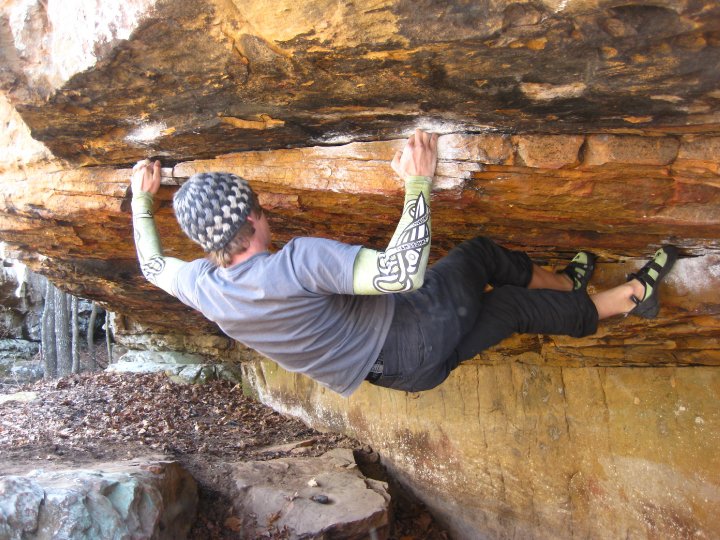Nick Hancock

Image courtesy of Joe Branch, via Facebook.
“Those were some good times,” Nick states while thinking back to his beginnings in the world of bouldering. He was a freshman in high school and his YoungLife leader would take he and members of the group out to climb after school and on the weekends as well as to practice on the 45-degree wall he had in his garage. It was also a bonding experience for Nick and his brother as they would learn the ropes (no pun intended) from several of their mutual friends. Though times were good, Nick had two hurdles to overcome: the cold and the height. “I was a 135 lb track runner and climbing is a cold weather sport…needless to say I wasn’t very insulated,” he remembers. After the initial shock of the weather, the head game of getting over heights took a lot of practice. “Before I did [get over the height] I earned the nickname Squid b/c I got into the habit of “squiding-out” as my climbing buds put it, which was a term that described my tendency to climb about 10 feet up, halfheartedly go for the next hold and then fall on purpose so that I didn’t get very high. I’ve moved on from both of those issues, but to this day I still go by Squid with a lot of those guys that I started climbing with.”
When remembering back to before he climbed, Nick claims that “climbing changed me [him] all around.” “Physically I went from 135 to 165 in a few years and got man hands.” He touts that these ‘man hands’ are great for “shaking hands with old guys, giving massages, and climbing rocks.” Given the nature of the sport, an important aspect of progressing in climbing is “about controlling your body weight and cutting off the extra–you’re only as strong as the strength left over after supporting your body weight.” As with many sports, Nick not only saw physical changes but mental ones as well. He states, “Mentally, it improved me. I developed a tough guy attitude, but in a wax on wax off kind of way. Aaron taught me the etiquette of the sport, how to be respectful, and used the time climbing together to help groom me into a Jesus following Man. I gained confidence in myself and had something to pour my energy into, it is an outlet. I can pour myself out into it and at the same time it charges me up, so maybe it’s a double outlet.”
Nick prefers bouldering over roped climbing and he has fierce convictions and philosophies behind that decision. “Boulderers don’t use ropes, but we’re not stupid. We don’t go over 25 feet and even then you have a good group of spotters and pads beneath you. Bouldering is often more gymnastic [than route climbing] as well. If route climbing is writing in print, bouldering is writing in cursive, sometimes in a hurry.” For every bouldering trip, he has a few necessities that are essential before he walks out the door: “Good shoes…good chalk… [and a] good pad, that’s about 4.5 inches thick to lay underneath you.” Nick’s primary requirement though is good people. “Good people to climb with know when to be quiet, when to be stoked, when to call it quits, and when to tell you to go for it even though you’re being a baby about something. Good people also spot you because they know how important it is and that the favor will be returned.”
As an Arkansas native, Nick is passionate about the climbing areas that are present here. “Arkansas is the hidden gem of American Climbing. We have stuff all over the place. Within an hour and a half in any direction there is probably something to climb. South you’ve got caves and steep stuff, to the west theres boulder gardens and cliffs, and I don’t know about the east, but I’d be willing to bet there’s something out there.” Most of all, though, Nick loves the land of the Ozarks. “To the North is where you’ll find my favorite place. It’s called Fountain Red and is named after the famed Fountain Bleu area of France. There you’ll find classic boulders in the upper area as well as a few dynamic climbs, and then in the lower area there is some amazing roof climbing which is my favorite. Roof climbing means you’re climbing horizontally like on the bottom of a table. This area has a 100ft long area that is 30 feet deep underneath this Cliffside and is chock full of boulder problems.” Given his love of bouldering, there’s no surprise that roof climbing is his favorite. One of the main differences in bouldering and roped climbing is the nature of the moves taken–bouldering moves being precise and micro, roped being more calculated and graceful.

Leave a comment